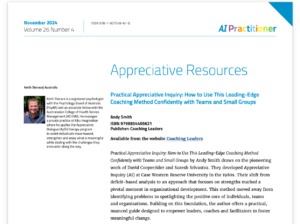How the Experience Cube Works in Coaching (2): Thinking

[ad_1]

The second in a series on how to use Gervase Bushe‘s ‘Experience Cube‘ model to explore your coaching client’s reality. It follows on from part 1 (Intro and Observing) which is here.
Thinking
We try to make sense of what we see and hear by making up stories which are our best guess about the causes of what is happening, and the motivations of any people involved.
As our brains give more weight to negatives, these made-up narratives are often worse than what’s really happening, causing unnecessary anxiety, or unwarranted anger at other people.
People often get thoughts and observations confused. They think they are talking about something they observe, when in fact they are describing their assumptions – they might say something like “I see you’re worried” or “I notice that you’re performing well under pressure.”
These are not observations. Rather, they are interpretations – a guess at someone else’s experience, or a value judgement the speaker has made.
To help a client distinguish between observations and stories/assumptions/judgements, the coach may find NLP’s Meta Model set of questions useful.
The Meta Model includes questions like “How do you know?” (to investigate a guess about another person’s state of mind presented as a fact) or “Performing well compared to what?” These should of course be used with enough ‘softeners’ to maintain rapport with the client.
If you’re more familiar with them, you could use questions derived from Cognitive Behavioural Therapy – although remember we’re just exploring here, not trying to argue the client out of ‘irrational’ beliefs.
The question “What else do you notice?” invites the client to observe in more detail than usual, or to cast their attention a bit wider or in different directions than they habitually do.
The question “Why?”, as in “Why do you believe that?”, is probably not that useful in a non-directive coaching context. You don’t know what kind of answers it will elicit. Will the client come up with rationalisations that support an unhelpful belief, entrenching it even further? Will they go back into the past to look for causal factors, casting themselves in ‘victim’ mode as the product of past events that they are powerless to alter? Or will the questioning uncover a whole structure of prior beliefs that underpin the current belief being questioned? This could be useful if you were in expert mode, diagnosing where a belief system has ‘gone wrong’ with an aim of fixing it, but it probably won’t help you in non-directive coaching.
The way the Experience Cube model invites the client (and the coach) to notice the difference between observations and thoughts is perhaps the most useful thing about it.
If you want to find out more about Gervase Bushe’s Experience Cube and the Clear Leadership approach that it comes from, get his excellent book, Clear Leadership: Sustaining Real Collaboration and Partnership at Work. In my view it’s a must-read for leaders, leadership coaches, and organisational development practitioners.
[ad_2]





